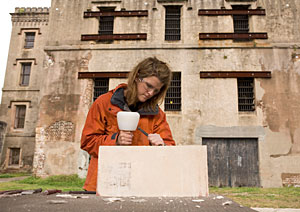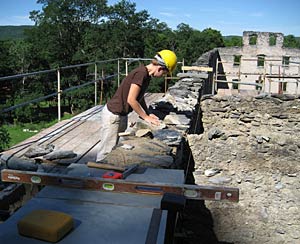When Hurricane Hugo ravaged Charleston, South Carolina, in 1989, more than 4,000 historical buildings were severely damaged. Due to a dearth of traditionally trained workers in the United States, European craftsmen were brought in to restore the structures, many of which dated back to the early 1800s.


Photos courtesy ACBA
Importing these types of experts may no longer be necessary. After getting licensed in 2004, the American College of Building Arts (ACBA), in Charleston, will graduate its first class next May. John Paul Huguley, a preservationist and structural engineer, founded the college, formerly the School of the Building Arts in Charleston, in 1998.Inspired by European restoration specialists, who are formally trained and supported by guilds, he modeled it after schools in France operated by Les Compagnons du Devoir, a 600-year-old organization for craftspeople.
The ACBA is not merely a trade school. It is the only four-year university in the U.S. that offers associates and bachelors degrees in the building arts. Students major in architecture or historic preservation and pick one of six concentrations: architectural metal, plaster working, masonry, carpentry, architectural stone, and timber framing. The students spend three days a week in the classroom, and two in the workshop. There are no electives, and each summer students must complete an eight-week internship in their concentration. “Every class is geared to fulfill a liberal arts curriculum, but in a very specific, integrated way,” explains Deborah Bowman, director of enrollment and student services. “Instead of biology, we have material science. Instead of the history of Charleston, we have the history of architecture.”
The college has an eclectic mix of scholars ranging in age from 17 to 30. Some are teenagers fresh out of high school, while others already have bachelor degrees. When classes got under way on August 13 for the fall semester, the campus welcomed a total of 60 students, one third of them female. Enrollment is increasing: there are 25 freshmen this year, a 60 percent increase from 2005. The annual tuition is $20,000.
When evaluating candidates, the selection committee considers standard criteria like high school transcripts and SAT scores. Applicants must also submit a portfolio showing their work, but special emphasis is placed on the interview. The program is rigorous, much like architecture school, and Bowman says they want to ensure students are passionate and mature enough to handle the demanding course load.
The school has two campuses: a former naval base houses the workshops, and the historic Old City Jail in downtown Charleston contains classrooms and administrative offices. In the future, the ACBA plans to expand to the McLeod Plantation, a 17th-century, 40-acre estate. This year, the senior class will assist with restoration work at the site.
Students say the program offers them a unique opportunity to get a bachelors degree while studying a trade. Isaiah Shaw, 24, became interested in timber framing while living in upstate New York, where old barns abound. He knew he wanted to pursue this line of work full-time, but he didn’t know how to go about it until he found the ACBA on the Internet. “It was my only option,” he says. “Smaller schools offered a week or three-month course, but nothing combined a liberal arts degree with the trade.” While Shaw is only a junior this year, his summer internships in New Hampshire and Rhode Island have already led to job offers.
In May, the college won an Arthur Ross award from the Institute of Classical Architecture & Classical America. Paul Gunther, the organization’s president, says the ACBA fills an important niche. “We are definitely seeing more of a need for these kinds of artisans,” he says, “not only in classical design but all kinds of construction.”




Post a comment to this article
Report Abusive Comment